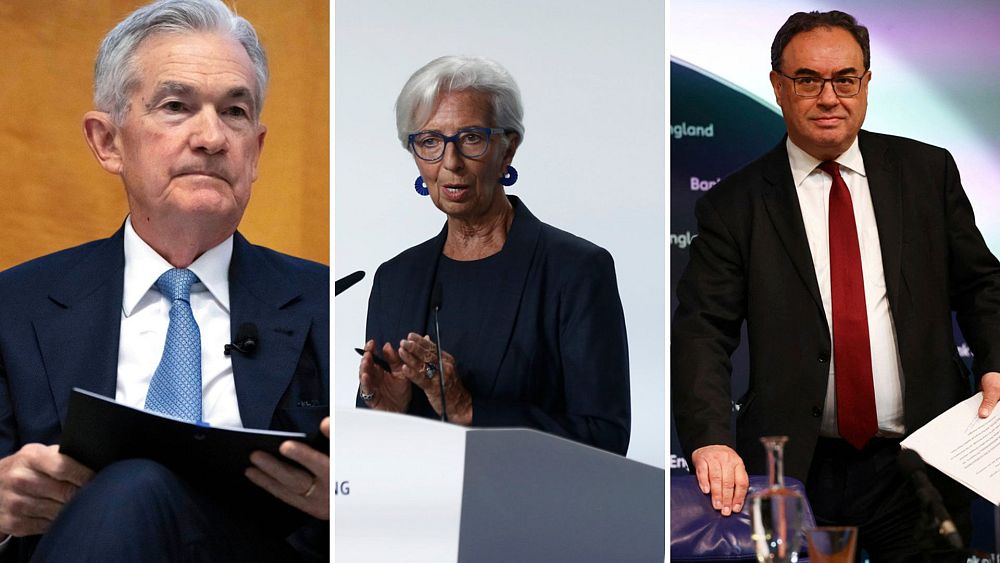Monetary policy decisions from some of the world’s biggest central banks will take centre stage this week, against a backdrop of global speculation that they are finished with lifting key interest rates.
The major European stock indexes were flat at around 11:00 CET on Monday morning, with investors closely monitoring market developments for the week: At the top of the agenda are the latest US inflation figures, alongside key interest rate decisions from some of the world’s most important central banks, including the US Federal Reserve (Fed), the European Central Bank (ECB), the Bank of England (BoE) and the Swiss National Bank (SNB).
Last week’s better-than-expected US job market report fuelled investor optimism about a soft landing for the economy and sent the S&P 500 index (which tracks the stock performance of the 500 biggest US-listed companies) and Nasdaq (the index tracking tech companies) to their highest closing levels since early 2022.
Oil and gold prices were in the negative on Monday morning, while Brent crude futures sat just above $75.20 (€69.86) a barrel and US West Texas Intermediate crude futures settled at around $70.60.
What is moving investors’ hands this week?
The ‘market roller coaster’ is expected to launch on Tuesday when, among other indicators, the US government will publish its report on consumer inflation. The figures will precede the Fed’s announcement about its next interest rate move on Wednesday, where analysts do not expect a rate change.
“When the Federal Reserve kept rates unchanged back in November […] there was still the distinct possibility that the final meeting of 2023 would provide the possibility of one more rate rise to round off the year,” said Michael Hewson, chief market analyst at CMC Markets UK.
“In the weeks since then the prospect of that now happening has disappeared to almost zero, despite Fed chair Jay Powell insisting at the start of this month that the prospect of more hikes was still a possibility and rate cuts could well follow in the coming months,” he added.
A series of central bank announcements will follow the Fed decision this week, with the ECB, the BoE, the SNB and Norway’s central bank declaring their latest decision on monetary policy on Thursday.
ECB: Inflation is down but not by enough
Investors in Europe are closely watching the ECB announcement. While the bank is unlikely to slash the current record-high key interest rates, the press briefing following the announcement will certainly be combed for hints as to when the Christine Lagarde-led institution will be ready to loosen the tight monetary conditions in the Eurozone.
The ECB has so far kept interest rates at record highs to help inflation slow to its 2% target. On the other hand, the EU economy is struggling to grow due to the high interest rates, which are unfavourable for new investments.
November’s inflation figures came in at an unexpectedly slow 2.4%, dropping sharply from 5.3% only three months before. Recent inflation data has triggered speculation that the ECB may cut rates sooner than expected, although this will certainly not be before the end of the year.
While there are no anticipated changes in policy, the biggest challenge facing Christine Lagarde is convincing the market that rate cuts won’t begin significantly before the summer of the next year, given the poor state of the European economy, according to Hewson.
The Monday mood among European investors has also been set by a fresh survey showing that the Eurozone is heading into a recession by the end of 2023. Economists polled by Bloomberg project the gross domestic product (GDP) shrinking by 0.1% in the final quarter of this year – quite the opposite of what the European Commission expects.
What to expect from the UK economy
The BoE’s final monetary policy meeting of 2023 will also give investors some clues as to when key interest rates will be cut. The expectation on the market is that the cost of borrowing will stay at a 15-year record high of 5.25% until the middle of 2024.
However, inflation shows signs of being more persistent than expected, as the consumer price index (CPI) rose by 4.6% in the 12 months to October 2023.
Hewson expects a “higher for longer approach”, meaning that interest rates are expected to remain elevated for an extended period.
“The Bank of England’s biggest concern however is wage growth which is currently at 7.9%,” he said, adding that markets are already pricing in some rate cuts for next year, “although these could well come after the ECB starts cutting”.
The latest UK wages data, expected to show a slower increase in wages, will be released on Tuesday, followed by Wednesday’s estimate on how UK GDP performed in October.
Having just about avoided a contraction in the three months to September, “some of the more recent economic data […] has shown a modest improvement,” said Hewson.
“Recent data has raised the prospect that the UK economy might avoid a recession at the end of this year,” he added.
How will tech contribute to this week’s ups and downs?
A few tech companies are also scheduled to report this week: Oracle’s earnings on Monday as well as Adobe’s report on Wednesday will shed light on how promising their cloud and AI products are.
“It’s been a strong year for the Adobe share price kicking on sharply despite briefly falling after its Q3 results,” said Hewson.
Adobe’s profits are expected to be driven by growth in its AI products. In the previous quarter, it reported a 10% revenue increase and a hefty $4.09 profit per share, with the shares rising to their best levels since December 2021 in the past few weeks.








